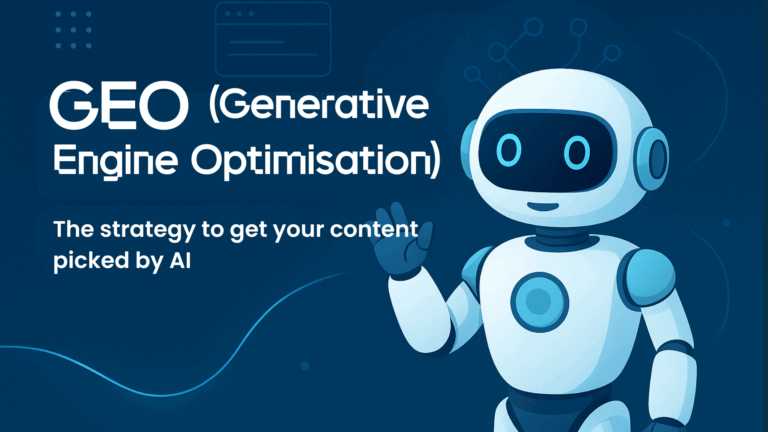What if your content was never seen by an AI?
Generative search engines like ChatGPT, Perplexity, or Google SGE are completely redefining the rules of the game. No longer are ranking algorithms the gatekeepers of visibility. Instead, large language models (LLMs) now summarise the web in seconds—and decide what gets included in their answers.
In this new reality, traditional SEO is no longer enough. Your content needs to be read, understood, and selected by AI systems in order to be surfaced in their responses.
Welcome to the age of GEO—Generative Engine Optimisation—a strategic approach designed to make your content “AI-ready”. In this article, you’ll learn why structuring your pages to meet the expectations of language models has become a powerful, though often invisible, growth lever.
Why Classic SEO isn’t enough anymore
Language models don’t operate like Googlebot.
-
They don’t crawl—they interpret.
-
They don’t “see” your backlinks or load speed—they look for structure, clarity, and intent.
SEO is about appearing. GEO is about being selected.
What is Generative Engine Optimisation (GEO)?
GEO is a natural evolution of SEO, designed for the new generation of AI-powered search engines. While traditional SEO aims to rank in the SERP, GEO seeks to:
-
Be cited, summarised, or rephrased in AI-generated answers
-
Adapt to how LLMs process and reproduce content
-
Deliver readable, credible, and extractable information
GEO vs SEO: Two fundamentally different logics
| Criteria | SEO | GEO |
| Target | Search algorithm | AI language model |
| Goal | Rank in the SERP | Be featured in an AI response |
| Output format | Clickable link | Summary block, citation, synthesis |
| Optimisation focus | Tags, backlinks, speed | Structure, readability, contextual relevance |
What AIs are really looking for
Why AIs don’t read like Googlebot:
Generative AIs don’t scroll—they absorb and rewrite. That’s why they favour:
-
Structured content: hierarchical headings, bullet points, FAQs
-
Concise writing: short sentences, direct answers
-
Credible sources: clear attribution, recognised brands
The takeaway: Your content must be designed to be synthesised, not just scanned.
E-Commerce in the Age of AI Search
1. The Rise of AI Overviews
Between January and March 2025, AI Overviews on Google doubled—from 6.49% to 13.14% of all queries.
88.1% of these queries were informational.
If your content (product pages, comparisons, guides) isn’t compatible with LLMs, it becomes invisible in these results.
2. Google’s AI-Powered Shopping Experience
Google recently introduced a new AI shopping mode, combining the Gemini model with its Shopping Graph, encompassing over 50 billion products. It enables users to:
-
Explore products based on needs
-
Virtually try on clothing via photo upload
-
Let an AI agent make purchases via Google Pay at the optimal time
The buying journey becomes assisted, predictive, and almost invisible.
3. Fewer clicks, but higher Conversions
In May 2024, BrightEdge reported a 30% drop in organic click-through rates on informational queries—directly linked to the growth of AI Overviews.
These AI blocks often take up 100% of the screen above the fold, pushing classic links below the fold.
However, there’s an upside: according to seoClarity, remaining clicks are more qualified.
Users who’ve already read an AI summary are closer to making a purchase—lower traffic, but higher intent.
How to make your Content GEO-friendly
Here’s your GEO-ready checklist:
| Élément | Why It Matters |
| Used as the base for AI synthesis | |
| Extractable by conversational AIs | |
| Easier for AIs to scan | |
| Helps interpret structure and logic | |
| Clean, scannable, extractable | |
| FAQPage, Product, Review tags | |
| Author, date, sources, brand authority |
Note: Each AI system behaves differently. ChatGPT, Perplexity, Google SGE, Mistral, and Claude all extract and process information in distinct ways.
Understanding their technical and behavioural nuances is key to effective optimisation.
GEO: A New Acquisition Channel
GEO isn’t just a tweak to your SEO—it’s a standalone channel. It drives visibility, influence, and conversions without requiring a click. A well-structured piece can be quoted, shape a decision, or trigger a purchase—all without the user ever visiting your site.
Scale GEO with EdgeSEO
EdgeSEO is the operational engine of GEO. It empowers marketing teams to industrialise their AI visibility without relying on traditional IT workflows.
Why Acquisition Teams struggle
Locked-down CMSs, tech backlogs, slow dev cycles… adapting to AI requirements often hits operational roadblocks.
The result? AIs end up citing your better-structured competitors.
EdgeSEO = Agility & Test-and-Learn
EdgeSEO enables marketing teams to:
-
Modify or enrich pages without touching the CMS
-
Inject FAQ blocks, markdown, or schema tags in real time
-
Dynamically adapt content based on user-agent (human vs AI)
-
Add a customised
llms.txtfile to guide what content LLMs should index or ignore
But most importantly, it enables fast testing and iteration—vital in an evolving AI landscape.
The Agile GEO Method: Test, Measure, Adjust
-
-
Identify content with GEO potential (FAQs, guides, comparisons)
-
Restructure it for AI: lists, headings, Q&A blocks
-
Deploy a markdown version
-
Add
llms.txtto signal what AIs should index -
Track citations, conversions, and AI mentions
-
Case Study: GEO-Ready Product Page – Before & After
| Before | After |
|---|---|
| Dense, unstructured text | Clear summary at the top |
| No markup | Schema.org Product + FAQ tags |
| Key info buried | “Key Features” section highlighted |
| No explicit answers | Short, Q&A-style extractable blocks |
Expected result: Featured in AI answers + improved product understanding
GEO + AEO = The Future-Proof Visibility Strategy
GEO targets generative AI responses.
AEO (Answer Engine Optimisation) focuses on voice search, rich snippets, and conversational queries. Together, they cover the full modern visibility spectrum:
-
Capture both conversational and generative searches
-
Appear in AI responses without relying on clicks
-
Position your brand at key intent moments
This is the strategy that future-proofs your brand beyond the traditional SERP.
Welcome to the Post-SERP Era
“SERPless” refers to a reality where users receive direct answers, without ever seeing a traditional results page.
It’s already happening: as mentioned, 88% of AI Overviews are triggered by informational queries.
So, ranking on Google is no longer enough. Now, you must aim for:
-
Share of AI voice
-
Quality of AI synthesis
-
Conversions without clicks
Take Action: GEO isn’t optional
If you want to:
✅ Be visible in AI-powered search
✅ Be cited in synthetic responses
✅ Be chosen before a click ever happens
… then start structuring, testing, and measuring now.
FAQ
A content strategy to make your pages understandable, summarised, and quotable by AI systems.
SEO = visibility in the SERP. GEO = visibility inside generated answers
Generative engines are absorbing traffic. Being cited = visibility. Not appearing = irrelevance.
Use intro summaries, hierarchical headings, Q&A formats, Schema markup, and E-E-A-T principles.
GEO structures for generative AI. AEO optimises for direct, often voice-based, answers.
Deploy GEO-ready content without relying on your CMS or IT. Rapid testing, fast feedback.
AI citation rate, share of AI voice, synthesis quality, and AI-led conversions.





















